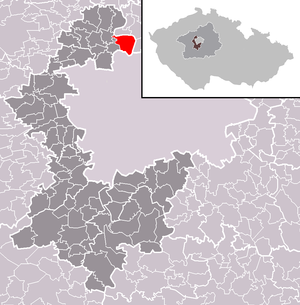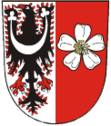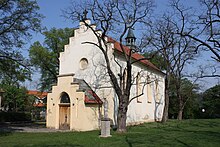Roztoky u Prahy
| Roztoky | ||||
|---|---|---|---|---|
|
||||
| Basic data | ||||
| State : |
|
|||
| Region : | Středočeský kraj | |||
| District : | Praha-západ | |||
| Area : | 844 ha | |||
| Geographic location : | 50 ° 10 ' N , 14 ° 24' E | |||
| Height: | 237 m nm | |||
| Residents : | 8,529 (Jan 1, 2019) | |||
| Postal code : | 252 63 | |||
| License plate : | S. | |||
| traffic | ||||
| Street: | Velké Přílepy - Prague | |||
| Railway connection: | Prague – Děčín | |||
| Next international airport : | Prague airport | |||
| structure | ||||
| Status: | city | |||
| Districts: | 1 | |||
| administration | ||||
| Mayor : | Jan Jakob (as of 2013) | |||
| Address: | Náměstí 5. května 2 252 63 Roztoky |
|||
| Municipality number: | 539627 | |||
| Website : | www.roztoky.cz | |||
| Location of Roztoky in the Praha-západ district | ||||

|
||||
Roztoky ( German Rostok ) is a city in the Czech Republic . It is located ten kilometers north of the city center of Prague on the city limits and belongs to the Okres Praha-západ .
geography
Roztoky is located on the edge of the Prague Basin ( Pražská kotlina ) on the Prague Plateau ( Pražská plošina ). The city lies on the left side of the Vltava at the confluence of the Únětický creek. The Dolní Povltaví Nature Park stretches across the river. The Klevetník (265 m) rises to the south-east and the Na Vršcích (297 m) to the south-west. The Prague – Děčín railway runs along the Vltava . State road II / 242 runs through Roztoky between Velké Přílepy and Prague. There is a ferry across the Vltava between Roztoky and Klecánky.
Neighboring towns are Plavidlo, Větrušice , Drasty and Hoštice in the north, Klecany and Přemyšlení in the Northeast, Klecánky, Brnky, Na Pekne Vyhlídce and Dolni Chabry in the east, Čimice, Bohnice and Zámky in the southeast, Maximiliánka, Na Háji, Za Hájem, Sedlec , Nový Suchdol and Starý Suchdol in the south, U Potůčku, Třešňovka, Na Skále, Horoměřice and Únětice in the south-west, Úholičky and Žalov in the west and Levý Hradec , Řež and Husinec in the north-west.
history
Archaeological finds show that the terraces at the mouth of the Únětický potok in the Vltava were inhabited since the Neolithic . Probably in the 9th century, the Přemyslids had the Levý Hradec Castle built as a new dominion center. After his baptism between 882 and 884, Duke Bořivoj I left the rotunda of St. Establish Kliment as the first Christian church in Bohemia. In the 12th century, the Přemyslids gave up the castle and the associated town.
Roztoky was first mentioned in a document in 1233 in connection with Peter von Rostok. In the 13th century at the mouth of the Únětický potok, the seat of the Lords of Rostok was the seat of a water fortress with a round floor plan, which was surrounded by a deep moat. There was also an abbot's house with a courtyard belonging to the Břevnov monastery . Between 1360 and 1374 the Rostok manor belonged to the Prague citizen Šimon Bohuslavův Olbramovec. His widow Markéta sold the estate to Eberhard von Reims ( z Remeše ) at the end of the 14th century . In 1381 he was inherited by his brother Reinhard, who had the fortress rebuilt. After the outbreak of the Hussite Wars , Reinhard von Reims , who was on the side of King Sigismund , was confiscated by the Prague Hussites. During this time, the Rostock ownership of the Břevnov monastery also expired. The Rostok estate was owned by various citizens of Prague's Old Town , including the scribe Jan von Pořešín. After the Battle of Lipan , Reinhard von Reims got the property back, after his death it fell to King Ladislaus Postumus . In the second half of the 15th century, the owner of the estate, Friedrich von Dohna ( Bedřich z Donína ) had the fortress redesigned in the Gothic style. At the end of the 15th and first half of the 16th century the estate belonged to the Lords of Schlick and later Elisabeth Smiřická of Smiřice . Their heirs sold Rostok to Ludwig Scheradin von Schorndorf; he was followed by the Cartesius family, who sold the estate in 1565 to the captain of the Schlaner district, David Borinie Ritter von Lhota . He had the fortress redesigned into a two-storey renaissance castle with an arcade. In 1606 his son David d. J. Borinie von Lhota took over the farm and the village of Lichtendorf from Christoph von Leskow and connected them to Rostok. After the Battle of White Mountain , David Borinie's property was confiscated. The court chamber sold the Rostok and Lichtendorf estates to Karl von Liechtenstein , who raised them to a family entrepre- neurship. During the Thirty Years War, the castle and the village were destroyed by Swedish troops in 1639. In 1784 Roztoky was partially flooded by a severe Vltava flood. The princes of Liechtenstein sold the Rostok entails in 1803 to Josef Mader and his son-in-law Joseph Löhner . Mader sold his half of the property in 1807 to Löhner, who thus became the sole owner of the Rostok estate with Lichtendorf. Laborer sold in the same year the court Auholičky to the citizens of Prague Martin Nowak and 1810 the yard Hoschtitz ( Hoštice ) to the owner of the domain Pakoměřitz ( Pakoměřice ), Count Friedrich von Nostitz . Since 1807 Löhner also owned the Statenitz estate , which he sold to Countess Barbara Khüenburg in 1821 . In this context Löhner exchanged the village and the Lichtendorf farm at Gut Statenitz for the Statenitz villages Husinetz , Řež and Žalow with Hradetz . He improved agriculture through the use of scientific methods and machines; He farmed the fields proportionally in alternating or coupled farming. He also remodeled wasteland and mountain slopes into forests and gardens. While the earlier viticulture hardly played a role, fruit growing became very important under Löhner. Joseph Löhner died in 1837, two years later the estate was given to his son Ludwig Edler von Löhner . He sold it on January 30, 1839 to the Prague citizen Joseph Leder and his wife Anna, née Geřabek, whose descendants held the estate until the beginning of the 20th century.
In 1843 the estate comprised a usable area of 1797 yoke 332 square fathoms, of which 715 yoke 489 square fathoms belonged to the authorities. The villages of Rostok, Žalow, Husinetz and Řež as well as seven houses of Klein-Kletzan ( Klecánky ) were subject to the estate. A total of 939 people lived in the area, including two Protestant and one Israelite families in Rostok. The village of Rostok / Rostoky consisted of 76 houses with 624 inhabitants. The local church of St. John the Baptist, the localist house and the school. In Rostok there was also an aristocratic castle, a dominical farm with sheep, a dominical brewery, a dominical brandy house, a dominical hunter's house, a Vltava overpass, an inn and two mills on the Vltava and one on the Aunjetitz brook. Rostok was the parish for Žalow, the church of St. Kliment in Hradetz belonged to the parish as a branch church. Until the middle of the 19th century, Rostok was the official village of the property of the same name.
After the abolition of patrimonial formed Roztoky / Rostok after 1850 with the hamlet Žalov a municipality in the county and judicial district Smíchov . The railway connection between Prague, Bodenbach and Dresden , established at that time by the Imperial and Royal Northern State Railways , brought more and more day trippers to the scenic area in Roztoky. This marked the beginning of Roztoky's change from an agricultural village to a summer resort and a meeting place for landscape painters. In the valley of Tiché údolí des Únětický potok, wealthy Prague citizens had villas built. At the same time, industrial companies also settled in Rostok. These included an oil factory, a fertilizer factory and the E. Oesinger factory for colored wood extracts. In 1867 Žalov broke away from Roztoky and formed its own municipality. In 1870 the factory of J.Felkl & Sohn, which was the only manufacturer of terrestrial globes in the kk monarchy, was established. In 1886 the mayor Matěj Vošahlík had the Rostok serpentines built. During his tenure, Rostok was raised to a market town in 1893. At the beginning of the 20th century, the agricultural entrepreneur Josef Wohanka bought a disused factory and built a cleaning and drying plant for beet seeds in it. In the first third of the 20th century, with the construction of the single-family housing estate Horní Roztoky, the expansion of Roztoky to the plateau above the Vltava valley began. At the same time, plans were made to build a city center in Horní Roztoky. In 1927 the minor city was assigned to the Praha-venkov district and the judicial district of Praha-západ. From 1929 Roztoky belonged to the judicial district Praha-sever. In 1932 Roztoky already had 2954 inhabitants. In 1942 Roztoky became part of the newly formed Praha-venkov-sever district. After the end of the Second World War, Roztoky came to the judicial district of Praha-západ. Between 1945 and 1948 the penicillin factory was established, which later became the Research Institute for Antibiotics and Biotransformation ( Výzkumný ústav antibiotik a biotransformací ). Roztoky has been part of Okres Praha-západ since 1949. In 1960 Žalov was incorporated. In the following years Žalov and Roztoky grew together due to the development of the plateau. In 1968 Roztoky was promoted to city and received a coat of arms. From the Research Institute for Antibiotics and Biotransformation, the ICN Czech Republic emerged in the 1990s, which today operates as VUAB Pharma as and is the largest company in the city. In 2002, the Vltava flood flooded the high dams at the castle and VUAB Pharma as and caused severe damage. In 2005 the new Solníky residential area was built on the fields northwest of the new main square in Horní Roztoky. Roztoky is now a satellite city of Prague with industrial settlements and large housing estates. Two Esko Prague lines operate via and to Roztoky.
City structure
No districts are designated for the city of Roztoky. It is divided into the cadastral districts of Roztoky u Prahy and Žalov . Settlement units are Háje, Horní Roztoky I, Horní Roztoky II, Na Dubečnici, Pobřeží, Průmyslový obvod, Roztoky-střed and Žalov.
Attractions
- Levý Hradec castle , northwest of Žalov above the Vltava valley
- Fortress Řivnáč, west of Žalov above the Vltava valley
- Pravý Hradec castle, north of the city on the opposite bank of the Vltava
- Church of St. Kliment in Levý Hradec
- Church of the Birth of John the Baptist in Horní Roztoky, it was built in 1865–1867 through the reconstruction of an old granary
- Statue of St. John of Nepomuk in front of the church in Horní Roztoky, created in 1845
- Roztoky Castle, it was built in the 17th century in place of a previous building that was destroyed during the Thirty Years War and was redesigned in the 19th century. The castle had been in a disrepair since the interwar period. After the estate and palace were nationalized in 1948, the palace was abandoned to complete disrepair and parts of the complex were demolished. Local historians have been trying to save the complex since the 1950s and in 1957 a museum was opened in the castle. The castle has been open to the public since 1961, and in 1974 the Středočeský kraj took over the museum as an exhibition of the Středočeský muzeum.
- Braunerův mlýn mill (No. 5) from the 19th century. In 1856 the politician František August Brauner bought the Malý mlýn . Subsequently, the mill next to Brauner's Prague house Na Perštýně became a center of Czech politics in the kk monarchy. Today there is an exhibition of the Středočeské muzeum on the work of Brauner's daughter, the painter Zdenka Braunerová, in the mill.
- Údolí Únětického potoka nature reserve with
- Holý vrch rock spur with the Alšova vyhlídka viewpoint , east of the village
- Kozí hřbety rock ridge, southeast of Únětice
- Valley Tiché údolí des Únětický potok below the village to the Vltava valley , with the four mills Roztocký, Spálený, Tůmův and Trojanův mlýn as well as several villas
- Villa Mia (No. 79), built in the 1850s, one of the summer guests was u. a. Bedrich Smetana
- Classicist Lobkowicz Castle (No. 10), built in 1869 in place of the New Mill
- Japanese style villa of writer Joe Hloucha
- Former Sakura luxury hotel, built in the 1920s next to Villa Hloucha. The building, also built in the Japanese style, was architecturally defaced in the 1970s when it was converted into a hospital
- Villa Bráf (No. 99), the former summer residence of Albín Bráf's family, who died there in 1912
Town twinning
- Skawina , Poland, since 2005
Personalities
sons and daughters of the town
- Ludwig von Löhner (1812–1852), Austrian doctor, poet and politician
- Emil Utitz (1883–1956), philosopher
- Jana Koubková (* 1944), jazz singer
- Zdeněk Jiskra (1928–2016), onomastics
They lived and worked in Roztoky
- František August Brauner (1810–1880), Czech politician and member of the Reichstag
- Zdenka Braunerová (1858–1934), painter
- Albín Bráf (1851–1912), economist, politician and journalist
- Čeněk Ryzner (1845–1923), the doctor and amateur archaeologist, is considered to be the discoverer of the Aunjetitz and the Řivnáč culture .
- Joe Hloucha (1881–1957), Czech Japanologist and writer
Web links
- History of Roztoky (Czech)
Individual evidence
- ↑ Český statistický úřad - The population of the Czech municipalities as of January 1, 2019 (PDF; 7.4 MiB)
- ↑ Johann Gottfried Sommer The Kingdom of Bohemia, Vol. 13 Rakonitzer Kreis, 1845 pp. 169–173
- ↑ http://www.uir.cz/katastralni-uzemi-obec/539627/Obec-Roztoky
- ↑ http://www.uir.cz/zsj-obec/539627/Obec-Roztoky
- ↑ http://www.roztoky.cz/partnerska-mesta





